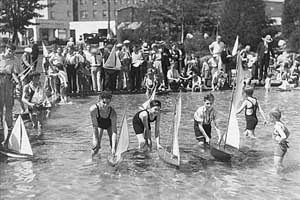In 2003, Washington state has its driest summer since record keeping began in 1895. A persistent ridge of high pressure stays off the Pacific coast all summer, preventing storms from coming ashore. The Office of the Washington State Climatologist reports that statewide, during the months of June, July, and August, Washington receives just 1.09 inches of precipitation, which is 70 to 85 percent below normal. The average summer rainfall for the state is typically 4.05 inches.
Washington State’s Driest Summers
- 2003 – 1.09 inches
- 1919 – 1.43 inches
- 1967 – 1.61 inches
- 1945 – 1.65 inches
- 1938 – 1.78 inches
As a comparison to Washington's driest summer in a century, the National Climate Data Center (NCDC), a division of the National Oceanic and Atmospheric Administration (NOAA), provided statistics for the state’s wettest summers.
Washington State’s Wettest Summers
- 1983 – 6.58 inches
- 1912 – 6.54 inches
- 1948 – 6.35 inches
- 1937 – 6.27 inches
- 1968 – 5.93 inches
Although Washington was dry, the mean average temperature (the sum of the high and low temperatures divided by 2) for the summer of 2003 was 66.4 degrees Fahrenheit, only 2.2 degrees above the norm of 63.55 degrees, making it only the fifth warmest summer on record. 1958 was the state’s warmest summer with an average temperature of 67.6 degrees.
Washington State’s Warmest Summers
- 1958 – 67.6 degrees
- 1961 – 67.2 degrees
- 1967 – 66.5 degrees
- 1998 – 66.5 degrees
- 2003 – 66.4 degrees
In Seattle, the warmest summer was in 1967 with a mean average temperature of 66.8 degrees Fahrenheit, the normal being 63.3 degrees. The long, dry summer of 2003 averaged 65.7 degrees, making it only Seattle’s fifth warmest summer on record.
Seattle’s Warmest Summers
- 1967 – 66.8 degrees
- 1958 – 66.5 degrees
- 1961 – 66.3 degrees
- 1992 – 66.2 degrees
- 2003 – 65.7 degrees
In 2003, the Puget Sound area had its second driest summer on record, measuring just 0.89 inch of precipitation during the months of June, July and August. Officially, the driest summer on record, measured by the National Weather Service Climate Monitoring Office at the Seattle-Tacoma International Airport (Sea-Tac), occurred in 1987 when rainfall measured only 0.84 inch, the norm being 3.3 inches. However, airport records only date back to 1945. Unofficially, records from downtown Seattle dating back to 1891 indicate that the area’s driest summer was in 1919, with a measly 0.65 inch of rainfall.
Seattle’s Driest Summers
- 1987 – 0.84 inches
- 2003 – 0.89 inches
- 1945 – 1.04 inches
- 1958 – 1.21 inches
- 1970 – 1.23 inches
As a comparison the National Climate Data Center (NCDC) provided statistics for the wettest summers in Seattle.
Seattle’s Wettest Summers
- 1968 – 8.34 inches
- 2001 – 6.43 inches
- 1983 – 6.16 inches
- 1964 – 6.04 inches
- 1975 – 5.70 inches
In 2003, Seattle set a new local record for the number of consecutive days of 70 degrees Fahrenheit or above at 61 days, from July 8th to September 7th. However that record hardly compares to Tacoma’s run of 80 consecutive days at 70-plus degrees in 1997. The old Seattle record for the number of consecutive days at 70 degrees or above, was 49 days set in 1958, from July 9th to August 26th.
Because of heavy spring rains in 2003, enough water was stored in Seattle’s two reservoirs to meet summer needs. But toward the end of the long dry-spell, rivers and streams across Western Washington were flowing at half their normal volume, with some at or near record low levels. Boaters at the Hiram M. Chittenden Locks in Ballard faced long waits because lock masters were reluctant to release too much water from Lake Union and Lake Washington into Puget Sound.
Ironically, just days after the long dry spell officially ended, Seattle set a new record for its wettest September day on record when 1.11 inches of rain was measured at the Sand Point Weather Station on September 16, 2003. The old record was 0.70 inch of rainfall measured on September 24, 1988. One month later, the National Weather Service Climate Monitoring Office reported an all-time record for a single day’s rainfall in the Seattle area when 5.02 inches of precipitation was measured at Sea-Tac on October 20, 2003, obliterating the old record of 3.41 inches set on November 20, 1959.

